Applied Mathematics and Mechanics (English Edition) ›› 2024, Vol. 45 ›› Issue (3): 461-478.doi: https://doi.org/10.1007/s10483-024-3098-5
• Articles • Previous Articles Next Articles
Haitao LI1, Tianyu ZHENG1, Weiyang QIN2, Ruilan TIAN3, Hu DING4,*( ), J. C. JI5, Liqun CHEN4
), J. C. JI5, Liqun CHEN4
Received:2023-11-14
Online:2024-03-03
Published:2024-02-24
Contact:
Hu DING
E-mail:dinghu3@shu.edu.cn
Supported by:2010 MSC Number:
Haitao LI, Tianyu ZHENG, Weiyang QIN, Ruilan TIAN, Hu DING, J. C. JI, Liqun CHEN. Theoretical and experimental study of a bi-stable piezoelectric energy harvester under hybrid galloping and band-limited random excitations. Applied Mathematics and Mechanics (English Edition), 2024, 45(3): 461-478.
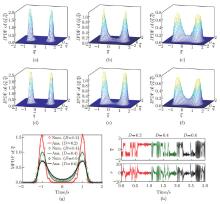
Fig. 3
Comparison of theoretical predictions and numerical simulations for D=0.2, D=0.4, and D=0.6. (a), (b), and (c): 3-D analytical prediction of JPDF with the SAM; (d), (e), and (f): 3-D numerical simulation of JPDF with the Euler-Maruyama method; (g) and (h): MPDF and time domain response for three random excitation levels ("Num." means numerical and "Ana." means analytical) (color online)"

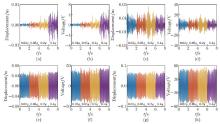
Fig. 7
Simulated time-domain responses of LEH-GR at four wind speeds. (a) and (b): U=1 m/s; (c) and (d): U=1.5 m/s; (e) and (f): U=2 m/s; (g) and (h): U=2.5 m/s. The lines of blue, brown, yellow, and purple represent the time domain displacement responses under the random excitation levels of 0.02g, 0.05g, 0.2g, and 0.4g, respectively (color online)"

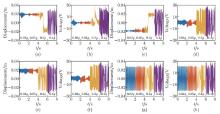
Fig. 8
Simulated time-domain responses of BEH-GR at four wind speeds. (a) and (b): U=1 m/s; (c) and (d): U=1.5 m/s; (e) and (f): U=2 m/s; (g) and (h): U=2.5 m/s. The lines of blue, brown, yellow, and purple represent the time domain displacement responses under the random excitation levels of 0.02g, 0.05g, 0.2g, and 0.4g, respectively (color online)"

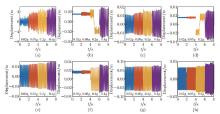
Fig. 11
Experimental time-domain displacement responses of LEH-GR and BEH-GR. (a) and (b): U=1 m/s; (c) and (d): U=1.5 m/s; (e) and (f): U=2 m/s; (g) and (h): U=2.5 m/s. The lines of blue, brown, yellow, and purple represent the time domain displacement responses under the random excitation levels of 0.02g, 0.05g, 0.2g, and 0.4g, respectively (color online)"

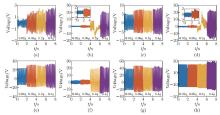
Fig. 12
Experimental time-domain voltage responses of LEH-GR and BEH-GR. (a) and (b): U=1 m/s; (c) and (d): U=1.5 m/s; (e) and (f): U=2 m/s; (g) and (h): U=2.5 m/s. The lines of blue, brown, yellow, and purple represent the time domain voltage responses under the random excitation levels of 0.02g, 0.05g, 0.2g, and 0.4g, respectively (color online)"

| 1 | YANG, Z., ZHOU, S., ZU, J., and INMAN, D. High-performance piezoelectric energy harvesters and their applications. Joule, 2, 642- 697 (2018) |
| 2 |
CAO, D., WANG, J., GUO, X., LAI, S. K., and SHEN, Y. Recent advancement of flow-induced piezoelectric vibration energy harvesting techniques: principles, structures, and nonlinear designs. Applied Mathematics and Mechanics (English Edition), 43 (7), 959- 978 (2022)
doi: 10.1007/s10483-022-2867-7 |
| 3 | DAQAQ, M. F., MASANA, R., ERTURK, A., and QUINN, D. D. On the role of nonlinearities in vibratory energy harvesting: a critical review and discussion. Applied Mechanics Reviews, 66, 040801 (2014) |
| 4 | WEI, C., and JING, X. A comprehensive review on vibration energy harvesting: modelling and realization. Renewable and Sustainable Energy Reviews, 74, 1- 18 (2017) |
| 5 | WANG, L., and YUAN, F. G. Vibration energy harvesting by magnetostrictive material. Smart Materials and Structures, 17, 1- 18 (2008) |
| 6 | HUYNH, B. H., TJAHJOWIDODO, T., ZHONG, Z. W., WANG, Y., and SRIKANTH, N. Design and experiment of controlled bistable vortex induced vibration energy harvesting systems operating in chaotic regions. Mechanical Systems and Signal Processing, 98, 1097- 1115 (2018) |
| 7 | FU, Y., OUYANG, H., and BENJAMIN, D. R. Nonlinear structural dynamics of a new sliding-mode triboelectric energy harvester with multistability. Nonlinear Dynamics, 100, 1941- 1962 (2020) |
| 8 | QIAN, F., ZHOU, S., and ZUO, L. Approximate solutions and their stability of a broadband piezoelectric energy harvester with a tunable potential function. Communications in Nonlinear Science and Numerical Simulation, 80, 104984 (2020) |
| 9 | LI, H. T., DING, H., JING, X. J., QIN, W. Y., and CHEN, L. Q. Improving the performance of a tri-stable energy harvester with a staircase-shaped potential well. Mechanical Systems and Signal Processing, 25, 107805 (2021) |
| 10 | LAI, S. K., WANG, C., and ZHANG, L. H. A nonlinear multi-stable piezomagnetoelastic harvester array for low-intensity, low-frequency, and broadband vibrations. Mechanical Systems and Signal Processing, 122, 87- 102 (2019) |
| 11 | DENG, T. C., and DING, H. Frequency band preservation: pipe design strategy away from resonance. Acta Mechanica Sinica, 40 (3), 523201 (2024) |
| 12 | CHEN, H. Y., MAO, X. Y., DING, H., and CHEN, L. Q. Elimination of multimode resonances of composite plate by inertial nonlinear energy sinks. Mechanical Systems and Signal Processing, 135, 106383 (2020) |
| 13 | CHEN, L. Q., and JIANG, W. A. Internal resonance energy harvesting. Journal of Applied Mechanics, 82, 031004 (2015) |
| 14 | YUAN, T., YANG, J., and CHEN, L. Q. Nonlinear characteristic of a circular composite plate energy harvester: experiments and simulations. Nonlinear Dynamics, 90, 2495- 2506 (2017) |
| 15 | YUAN, T., YANG, J., and CHEN, L. Q. Nonlinear dynamics of a circular piezoelectric plate for vibratory energy harvesting. Communications in Nonlinear Science and Numerical Simulation, 59, 651- 666 (2018) |
| 16 | ZHOU, W., WANG, B., LIM, C. W., and YANG, Z. A distributed-parameter electromechanical coupling model for a segmented arc-shaped piezoelectric energy harvester. Mechanical Systems and Signal Processing, 146, 107005 (2020) |
| 17 | FAN, K., CAI, M., LIU, H., and ZHANG, Y. Capturing energy from ultra-low frequency vibrations and human motion through a monostable electromagnetic energy harvester. Energy, 169, 356- 368 (2019) |
| 18 | WANG, C., ZHANG, Q., and WANG, W. Low-frequency wideband vibration energy harvesting by using frequency up-conversion and quin-stable nonlinearity. Journal of Sound and Vibration, 399, 169- 181 (2017) |
| 19 | VOCCA, H., NERI, I., TRAVASSO, F., and GAMMAITONI, L. Kinetic energy harvesting with bistable oscillators. Applied Energy, 97, 771- 776 (2012) |
| 20 |
LU, Z., LI, K., DING, H., and CHEN, L. Nonlinear energy harvesting based on a modified snap-through mechanism. Applied Mathematics and Mechanics (English Edition), 40 (1), 167- 180 (2019)
doi: 10.1007/s10483-019-2408-9 |
| 21 | LI, H. T., QIN, W. Y., ZU, J., and YANG, Z. Modeling and experimental validation of a buckled compressive-mode piezoelectric energy harvester. Nonlinear Dynamics, 92, 1761- 1780 (2018) |
| 22 | ZHAO, L. C., ZOU, H. X., YAN, G., ZHANG, W. M., PENG, Z. K., and MENG, G. Arbitrary-directional broadband vibration energy harvesting using magnetically coupled flextensional transducers. Smart Materials and Structures, 27, 095010 (2018) |
| 23 | YANG, W., and TOWFIGHIAN, S. A hybrid nonlinear vibration energy harvester. Mechanical Systems and Signal Processing, 90, 317- 333 (2017) |
| 24 | LALLART, M., ZHOU, S., YAN, L., YANG, Z., and CHEN, Y. Tailoring multistable vibrational energy harvesters for enhanced performance: theory and numerical investigation. Nonlinear Dynamics, 96, 1283- 1301 (2019) |
| 25 | YANG, T., CAO, Q., LI, Q., and QIU, H. A multi-directional multi-stable device: modeling, experiment verification and applications. Mechanical Systems and Signal Processing, 146, 106986 (2020) |
| 26 | ZHANG, J., YANG, K., and LI, R. A bistable nonlinear electromagnetic actuator with elastic boundary for actuation performance improvement. Nonlinear Dynamics, 100, 3575- 3596 (2020) |
| 27 | STANTON, S. C., MCGEHEE, C. C., and MANN, B. P. Nonlinear dynamics for broadband energy harvesting: investigation of a bistable piezoelectric inertial generator. Physica D: Nonlinear Phenomena, 239, 640- 653 (2010) |
| 28 | ERTURK, A., HOFFMANN, J., and INMAN, D. J. A piezomagnetoelastic structure for broadband vibration energy harvesting. Applied Physics Letters, 94, 254102 (2009) |
| 29 | CAO, J., WANG, W., ZHOU, S., INMAN, D. J., and LIN, J. Nonlinear time-varying potential bistable energy harvesting from human motion. Applied Physics Letters, 107, 143904 (2015) |
| 30 | ZHOU, Z., QIN, W., DU, W., ZHU, P., and LIU, Q. Improving energy harvesting from random excitation by nonlinear flexible bi-stable energy harvester with a variable potential energy function. Mechanical Systems and Signal Processing, 115, 162- 172 (2019) |
| 31 | HAO, M. Y., DING, H., MAO, X. Y., and CHEN, L. Q. Multi-harmonic resonance of pipes conveying fluid with pulsating flow. Journal of Sound and Vibration, 569, 117990 (2024) |
| 32 | COTTONE, F., GAMMAITONI, L., VOCCA, H., FERRARI, M., and FERRARI, V. Piezoelectric buckled beams for random vibration energy harvesting. Smart Materials and Structures, 21, 035021 (2012) |
| 33 | ZHAO, S., and ERTURK, A. Electroelastic modeling and experimental validations of piezoelectric energy harvesting from broadband random vibrations of cantilevered bimorphs. Smart Materials and Structures, 2, 015002 (2013) |
| 34 | FANG, S., FU, X., and LIAO, W. H. Asymmetric plucking bistable energy harvester: modeling and experimental validation. Journal of Sound and Vibration, 459, 114852 (2019) |
| 35 | XU, M., WANG, B., LI, X., ZHOU, S., and YURCHENKO, D. Dynamic response mechanism of the galloping energy harvester under fluctuating wind conditions. Mechanical Systems and Signal Processing, 166, 108410 (2022) |
| 36 |
JIANG, W. A., SUN, P., ZHAO, G. L., and CHEN, L. Q. Path integral solution of vibratory energy harvesting systems. Applied Mathematics and Mechanics (English Edition), 40 (4), 579- 590 (2019)
doi: 10.1007/s10483-019-2467-8 |
| 37 | BARRERO-GIL, A., ALONSO, G., and SANZ-ANDRES, A. Energy harvesting from transverse galloping. Journal of Sound and Vibration, 329, 2873- 2883 (2010) |
| 38 | ABDELKEFI, A., YAN, Z., and HAJJ, M. R. Modeling and nonlinear analysis of piezoelectric energy harvesting from transverse galloping. Smart Materials and Structures, 22, 025016 (2013) |
| 39 | LI, H., DING, H., and CHEN, L. Chaos threshold of a multistable piezoelectric energy harvester subjected to wake-galloping. International Journal of Bifurcation and Chaos, 29, 1950162 (2019) |
| 40 | TAN, T., HU, X., YAN, Z., and ZHANG, W. Enhanced low-velocity wind energy harvesting from transverse galloping with super capacitor. Energy, 187, 115915 (2019) |
| 41 | WANG, J., ZHAO, W., SU, Z., ZHANG, G., LI, P., and YURCHENKO, D. Enhancing vortex-induced vibrations of a cylinder with rod attachments for hydrokinetic power generation. Mechanical Systems and Signal Processing, 145, 106912 (2020) |
| 42 | TANG, L., ZHAO, L., YANG, Y., and LEFEUVRE, E. Equivalent circuit representation and analysis of galloping-based wind energy harvesting. IEEE-ASME Transactions on Mechatronics, 20, 834- 844 (2015) |
| 43 | JAVED, U., and ABDELKEFI, A. Impacts of the aerodynamic force representation on the stability and performance of a galloping-based energy harvester. Journal of Sound and Vibration, 400, 213- 226 (2017) |
| 44 | DAI, H. L., ABDELKEFI, A., JAVED, U., and WANG, L. Modeling and performance of electromagnetic energy harvesting from galloping oscillations. Smart Materials and Structures, 24, 045012 (2015) |
| 45 | DAI, H. L., YANG, Y. W., ABDELKEFI, A., and WANG, L. Nonlinear analysis and characteristics of inductive galloping energy harvesters. Communications in Nonlinear Science and Numerical Simulation, 59, 580- 591 (2018) |
| 46 | ZHOU, Z., QIN, W., ZHU, P., and SHANG, S. Scavenging wind energy by a Y-shaped bi-stable energy harvester with curved wings. Energy, 153, 400- 412 (2018) |
| 47 | ABDELMOULA, H., and ABDELKEFI, A. Investigations on the presence of electrical frequency on the characteristics of energy harvesters under base and galloping excitations. Nonlinear Dynamics, 89, 2461- 2479 (2017) |
| 48 | BIBO, A., ABDELKEFI, A., and DAQAQ, M. F. Modeling and characterization of a piezoelectric energy harvester under combined aerodynamic and base excitations. Journal of Vibration and Acoustics, 137, 031017 (2015) |
| 49 | BIBO, A., and DAQAQ, M. F. Energy harvesting under combined aerodynamic and base excitations. Journal of Sound and Vibration, 332, 5086- 5102 (2013) |
| 50 | LIU, H., and GAO, X. Vibration energy harvesting under concurrent base and flow excitations with internal resonance. Nonlinear Dynamics, 96, 1067- 1081 (2019) |
| 51 | YAN, Z., and ABDELKEFI, A. Nonlinear characterization of concurrent energy harvesting from galloping and base excitations. Nonlinear Dynamics, 77, 1171- 1189 (2014) |
| 52 | ZHAO, L., and YANG, Y. An impact-based broadband aeroelastic energy harvester for concurrent wind and base vibration energy harvesting. Applied Energy, 212, 233- 243 (2018) |
| 53 | LI, H. T., DONG, B. J., CAO, F., QIN, W. Y., DING, H., and CHEN, L. Q. Nonlinear dynamical and harvesting characteristics of bistable energy harvester under hybrid base vibration and galloping. Communications in Nonlinear Science and Numerical Simulation, 125, 107400 (2023) |
| 54 | YANG, K., ABDELKEFI, A., LI, X., MAO, Y., DAI, L., and WANG, J. Stochastic analysis of a galloping-random wind energy harvesting performance on a buoy platform. Energy Conversion and Management, 238, 114174 (2021) |
| [1] | Qiong WANG, Zewen CHEN, Linchuan ZHAO, Meng LI, Hongxiang ZOU, Kexiang WEI, Xizheng ZHANG, Wenming ZHANG. Enhanced galloping energy harvester with cooperative mode of vibration and collision [J]. Applied Mathematics and Mechanics (English Edition), 2022, 43(7): 945-958. |
| [2] | Xiao-Hui LIU;Bo YAN;Hong-Yan ZHANG;Song ZHOU. Nonlinear numerical simulation method for galloping of iced conductor [J]. Applied Mathematics and Mechanics (English Edition), 2009, 30(4): 489-501. |
| [3] | GU Ming;LIU Ci-jun;XU You-lin;XIANG Hai-fan. RESPONSE CHARACTERISTICS OF WIND EXCITED CABLES WITH ARTIFICIAL RIVULET [J]. Applied Mathematics and Mechanics (English Edition), 2002, 23(10): 1176-1187. |
| Viewed | ||||||
|
Full text |
|
|||||
|
Abstract |
|
|||||


 Email Alert
Email Alert RSS
RSS